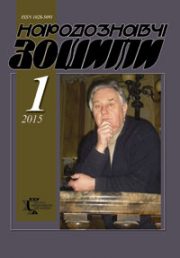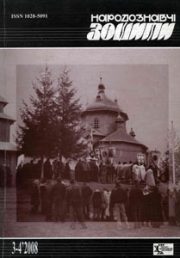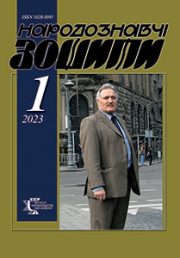The Ethnology Notebooks. 2025. № 3 (183), 529—536
UDK 745.51-057.8:7.046.3(477.83)
DOI https://doi.org/10.15407/nz2025.03.529
ZVARICH Igor
- ORCID ID: https://orcid.org/0009-0007-2092-5739
- Senior exhibitor of the Department of Art Wood,
- Lviv National Academy of Mysteries,
- 38, Kubiyovicha str., 79011, Lviv, Ukraine,
- Contacts: e-mail: zvarychwoodart@gmail.com
Abstract. The main goal of the publication is to highlight some aspects of the technological processes of manufacturing wooden structures as components of the iconostasis of the Holy Trinity Church in Zhovkva, which have undergone transformation over several centuries and have therefore acquired a partially modified expression of the object.
The relevance of the topic is due to the need to emphasize the flourishing of woodcarving in the 17th—18th centuries in the territories of western Ukraine, which is one of the brightest pages in the history of Ukrainian monumental and decorative art. Using the example of the aforementioned sacred object, one can observe a high level of awareness of church carving, decorative features of carpentry techniques, and the overall compositional structure of the church interior decoration.
In addition, the relevance is also due to the fact that the described and analyzed methods, techniques and means can serve as the key to solving a considerable number of restoration problems that undoubtedly arise and will arise both for specialists who take care of museum collections and for those church communities that use highly artistic examples of carved iconostases.
Problem statement. The presented material is an attempt to draw attention to the combination of styles from different periods that have coexisted in one monument for centuries. Special emphasis is placed on the author’s professional carpentry work, which indicates the high-quality execution of the components of the iconostasis design and the combination of structural elements from different periods in the overall ensemble of the iconostasis.
Keywords: iconostasis of the Church of the Holy Trinity near Zhovkva, craftsmanship, construction, carving, cleaning, cooperage, woodworking trade.
Received 5.06.2025
REFERENCE
- Otkovych, T.M. (2021). Collection of materials of the meeting of the International Restoration Council of the UNESCO World Heritage Site «Wooden Churches of the Carpathian Region of Poland and Ukraine». «Iconostasis of the Church of the Holy Trinity. Stylistic and iconographic features» (Pp. 54—60). Lviv [in Ukrainian].
- Dragan, M. (1970). Ukrainian decorative carving of the 16th—18th centuries (P. 121). Kyiv: Naukova dumka [in Ukrainian].
- Ovsiychuk, V. (1991). Masters of Ukrainian Baroque: Zhovka Art Center (P. 362). Kyiv: Naukova dumka [in Ukrainian].
- Zholtovsky, P. (1966). Easel painting. History of Ukrainian art (Vol. 3). Kyiv [in Ukrainian].
- Stankevych, M. (2002). Ukrainian Artistic Tree of the 16th—20th Centuries. Lviv: Institute of Ethnology of the NAS of Ukraine [in Ukrainian].
- Bolyuk, O. (2011). Fundamentals of systematization of wooden equipment and architectural elements of church interiors. Ethnology notebooks, 4, 674—677 [in Ukrainian].
- Partsey, M. (2005). Ancient Zhovkva. Booklet «The Church of the Holy Trinity in Zhovkva» (P. 119). Lviv: Svit [in Ukrainian].
- Osmak, G., Otkovych, T., & Kozak, O. (2006). The Church of the Descent of the Holy Spirit in Rohatyn and its iconostasis (artistic, biological and chemical research). Information issue, bulletin, 8, 112 [in Ukrainian].
- Biletska-Zvarych, M. (2021). Collection of materials of the meeting of the International Restoration Council of the UNESCO World Heritage Site «Wooden Churches of the Carpathian Region of Poland and Ukraine». «Research and restoration of the iconostasis from the Church of the Holy Trinity in Zhovkva» (Pp. 66—71). Lviv [in Ukrainian].
- Otkovych, T. (2006). Iconostasis of the Church of the Holy Trinity in Zhovkva (research and restoration). Newsletter of the Lviv Branch of the National Research Restoration Center of Ukraine, 2 (8), 130 [in Ukrainian].
- Slobodyan, V. (2013). Acts of visitations of the 18th century Church of the Holy Spirit in Rohatyn. Materials of the scientific and practical conference «Rohatyn Church of the Holy Spirit through the prism of history» (to the 30th anniversary of the status of a museum-monument of wooden architecture and painting of the 16th—19th centuries) 1983—2013 (P. 21). Ivano-Frankivsk: Simyk [in Ukrainian].
- Kudrytsky, A.V. (Ed.). (1997). Biographical Directory. Art of Ukraine (P. 565). Kyiv [in Ukrainian].







